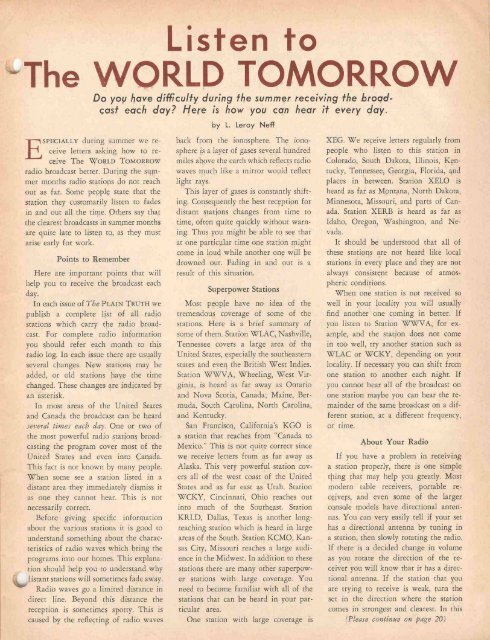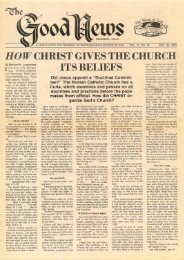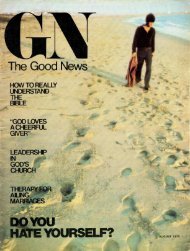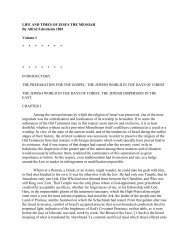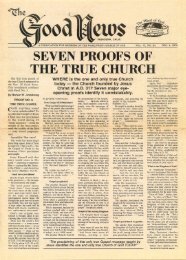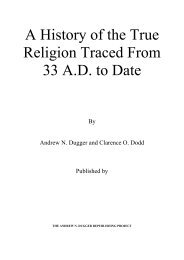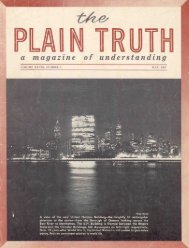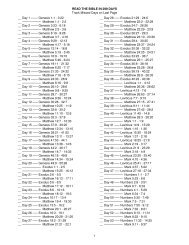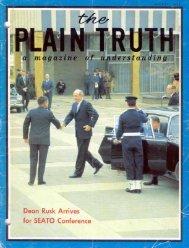Plain Truth 1962 (Vol XXVII No 08) Aug - Lcgmn.com
Plain Truth 1962 (Vol XXVII No 08) Aug - Lcgmn.com
Plain Truth 1962 (Vol XXVII No 08) Aug - Lcgmn.com
Create successful ePaper yourself
Turn your PDF publications into a flip-book with our unique Google optimized e-Paper software.
Listen to<br />
The WORLD TOMORROW<br />
SPECIALLY during summer we receive<br />
letters asking how to receive<br />
The WORLD TOMORUOW<br />
E<br />
radio broadcast heuer. During the Sttll1-<br />
mer months radio stations do nor reach<br />
our as far. Some people srare that (he<br />
station [hey cusromarily listen to fades<br />
in and our all the tirpe. Drqers say thaf<br />
the clearest broadcasts in sump1er months<br />
are quite late to lister ro, as they must<br />
arise early for work.<br />
Points to Remember<br />
Do yoy have diHiculty during the summer receiving the broqdcast<br />
each day? Here IS how you can hear it every day.<br />
Here are important points thar will<br />
help you to receive the broadcast each<br />
day.<br />
In each issue of The PLAIN TRUTH we<br />
publish a <strong>com</strong>plete list of all radjo<br />
stations which carry ere radio broadcast.<br />
For <strong>com</strong>plete radio Information<br />
you should refer each month to this<br />
radio log. In each issue there are usually<br />
several changes. New station~ may be<br />
added, or old stations haye the time<br />
changed. These changes are indicated by<br />
an asterisk.<br />
In most areas of rhe United States<br />
and Canada the broadcast can be heard<br />
seve-ral times each day. One or twO of<br />
the most powerful radio srations broadcasring<br />
the program cover mOst of rhe<br />
United States and even inro Canada.<br />
This fact is nor known by many people.<br />
When some see a station listed in a<br />
distant area they immediately dismiss it<br />
as one they cannot hear. This js nOt<br />
necessarily correer.<br />
Before giving specific information<br />
about the various stations it is good co<br />
understand something about the characteristics<br />
of radio waves which bring the<br />
programs into otlr homes. This explanarion<br />
should help you to understand why<br />
1istant srations will sometimes fade away.<br />
Radio waves go a limited distance in<br />
direct line. Beyond this distance the<br />
reception is sometimes SpOtty. This is<br />
caused by the reflectin~ of radio waves<br />
by l. Leroy Neff<br />
back from the ionosphere. The ionosphere<br />
is a layer of gases several hundred<br />
miles above the earth which reReers radio<br />
waves much like a mirror would reflect<br />
light rays.<br />
This layer of gases is consrantly shifting.<br />
Consequently the best reception for<br />
distant stations changes from time to<br />
time. often quite quickly witham warning.<br />
Thus you might be able co see that<br />
at one particplar time one station might<br />
<strong>com</strong>e in louq while another one will be<br />
drowned OUt. Fading in and oue is a<br />
result of this situation.<br />
Superpower Stations<br />
Most people have no idea of the<br />
trernendous cpverage of some of the<br />
starions. Here is a brief summary of<br />
some of chern. Station WLAC, Nashville,<br />
Tennessee covers a large area of thQ<br />
United Scates. especially the southeastern<br />
states and eveI1 the British Wesr Indies.<br />
Station W\y/VA, Wheeling, West Virginia,<br />
is heard as far away as Ontario<br />
and <strong>No</strong>va Scoria, Canada; Maine, Bermuda,<br />
SOUth C~rolina, <strong>No</strong>rth Carolina,<br />
and Kentucky.<br />
San FranciscQ, Californip.'s KGO is<br />
a station that reaches from "Canada to<br />
Mexico." This is nor quite correct since<br />
we receive letters from as far away as<br />
Alaska. This very powerful station covers<br />
all of the west coast of the Uniced<br />
Scates and as far east as Utah. Stacion<br />
WCKY, Cincinnati, Ohio reaches Out<br />
into much of the SOuth~f1st. Starion<br />
KRLD, Dallas, Texas i\ another longreaching<br />
station which is heard in large<br />
areas 01 the SoUth. Station KCMO, Kansas<br />
City, Missouri reaches a large audience<br />
in the Midwest. In addition to these<br />
stations there are many other superpower<br />
stations with large coverage. You<br />
need to be<strong>com</strong>e familiar with all of the<br />
stations that can be heard in your particular<br />
area.<br />
One station with large coverage is<br />
XEG. We receive letters regularly from<br />
people who listen to this station in<br />
Colorado, SoUth Dakoca, Illinois, K~n·<br />
tucky, Tennessee, Georgia, Florida, 'lod<br />
places in 'between. Station XELO is<br />
heard as far as Mpntana, <strong>No</strong>rth Dakora,<br />
Minnesota, Missouri, and parts of Canada.<br />
Station XERB is heard as far as<br />
Idaho, Ore$on, Washington, and Nevada.<br />
It should be understood that all of<br />
these statiOIlS are nOt heard like local<br />
stations in every place and they are not<br />
always consistent because of atmos.<br />
pheric conditions.<br />
When one station is npc received so<br />
well in your locality you will usually<br />
find another' one <strong>com</strong>ing in better. if<br />
you listen to Station WWV A, for example,<br />
and the stat jon does not <strong>com</strong>e<br />
in tOO well, try another station such as<br />
WLAC or WCKY, depending on your<br />
locality. If necessary you can shift from<br />
one station to another each night. If<br />
you caonot hear all of the broadcasr on<br />
one station maybe you can hear the reo<br />
mainder of the same proadcast on a dif·<br />
ferent station, at a different frequency,<br />
pr time.<br />
About Your Radio<br />
If you have a problem in receiving<br />
a station properly, there is one simple<br />
tping fhar may hell' you greatly. Most<br />
modern table receivers, portable receivers,<br />
and even some of the larger<br />
console models have directional antennas.<br />
You can very easily tell if your set<br />
has a directional amenna by cuning in<br />
a station, then slowly rorating the radio.<br />
U there is a dec ided change in volume<br />
as you rOtate the direcrion of the receiver<br />
you will know that ir has a direc·<br />
tional anrenna. If the station that yqu<br />
are trying to receive is weak, rum the<br />
set in the direction where the station<br />
<strong>com</strong>es in strongesr and clearest. In tlhis<br />
(Please contin"e on page 20)


